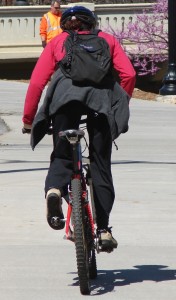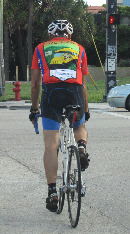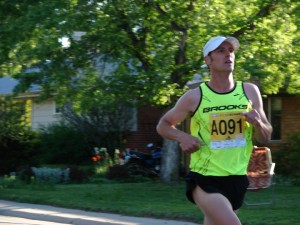Posts Tagged ‘triathlon’
You don’t have to be a hard-core athlete to appreciate endurance. Sometimes we want to push ourselves physically, for all sorts of reasons. Walking 18 holes. Winning the football game. Playing doubles. Running that annual 5K. A long bike ride on Saturday.
 So it’s “competition” day . . . now what? You may have trained and trained, but have you consistently fueled your body with the right substances (foods and fluids)? It really matters what fuel you choose; why wouldn’t it? And the body’s energy is finite: if it’s not resupplied, it will run out. Push it hard, it runs out faster. Fuel incorrectly, and all your training will be for naught. What a pity.
So it’s “competition” day . . . now what? You may have trained and trained, but have you consistently fueled your body with the right substances (foods and fluids)? It really matters what fuel you choose; why wouldn’t it? And the body’s energy is finite: if it’s not resupplied, it will run out. Push it hard, it runs out faster. Fuel incorrectly, and all your training will be for naught. What a pity.
Here are some Keys to give you a competitive edge. They will unlock a new level of physical success for you, in whatever arena you need it.
Key #1. Plan, plan, plan. You already know you need to prepare physically for an event. But even more key is planning ahead nutritionally. Take time to learn how starches, carbs, protein and hydration fuel the body for highly physical endeavors, and how they’re also used to help it recover quickly, building lean muscle tissue as a result. I’ve given you some great starter tips below.
Key #2. Practice, practice, practice . . . but I don’t mean training! Literally practice your “competition day” eating before that important event. A coach once told me ‘ if you put the maximum effort into your practice, you will have the maximum benefit during your game days.’ Now I tell all my athletes that same thing.
Key #3. Fuel properly the night before. The big pre-competition “no-no’s” are 1) anything with a lot of sugar; 2) fried or spicy foods; 3) high fat foods: gravies, sauces, creamy soups, fatty meats. And DON’T try any foods you’ve never eaten before.
Key #4. Same no-no’s apply on game day. Eat starches approximately 3-4 hours prior to your event, and make the portions slightly smaller than normal meal. They give you “timed-release” energy. About 30-60 minutes before starting the event, top off your tank with fluids and a small snack (a piece of fruit or granola bar).
Key #5. During your competition (or on tournament days with multiple events or games) make sure you’re drinking at least 8-12 ounces of fluids between each game or event. Eat a healthy snack – such as yogurt, a sports bar or trail mix – between each game and event. If you’re exercising for longer than an hour without taking a long break, you need to keep refueling during the event, with foods like pretzels, fruit, granola or fruit snacks. Remember: drink plenty of fluids!
Key #6. When in doubt DON’T go without! Some people find that liquids are easier on their stomachs while they exercise. But what’s in the liquid is critical. Don’t go without proteins or nutrients; try chocolate milk, smoothies, or meal replacement shakes.
Got it? Plan ahead, practice, hydrate and don’t go without fuel.
Exercise requires energy, pure and simple. But where does it come from? The answer is glycogen. But what is it?
 When we digest food we’ve eaten, the carbohydrates are broken down by our bodies into glucose, and then the glucose is stored in our muscles . . . as glycogen. During periods of exercise, this process reverses, and glycogen converts to glucose once again, so that is may be used for energy. How long we “last” is greatly influenced by how much glycogen we have stored in our muscles.
When we digest food we’ve eaten, the carbohydrates are broken down by our bodies into glucose, and then the glucose is stored in our muscles . . . as glycogen. During periods of exercise, this process reverses, and glycogen converts to glucose once again, so that is may be used for energy. How long we “last” is greatly influenced by how much glycogen we have stored in our muscles.
Exercise that lasts less than 90 minutes is typical for most of us. Carbs typically provide 40-50% of our energy in the beginning stages of moderate exercise. What the body naturally stores will sustain you through a workout of this length.
But as the intensity of physical activity increases, the body’s carbohydrate consumption increases too. For events over 90 minutes, eat a heavy-carb diet for 2-3 days prior.
Picture the muscles like porous rocks. The more glycogen is filling all those crevices, the more energy reserves we have to draw upon. This is why cyclists, marathoners, triathletes, soccer players and other endurance athletes excel when they’ve pre-loaded for 2-3 days with about 70% carbs. Glycogen is the fuel which sustains the body in highly physical situations.
Have you heard the term “hitting the wall?” This refers to an actual event in the body, the depletion of glycogen. Once stores are gone, energy is truly kaput; you have no way to generate more.
Don’t assume you should eat a high-carb diet all the time, though, even if you exercise heavily. Once glycogen fills all the areas where reserves can be stored, any extra that is produced is stored as body fat. Eating too many carbs causes this excessive glycogen production.
Another danger of overdoing carb consumption: you can unwittingly “train” your body not to utilize essential fatty acids that come from fat. Not only does fat transport cholesterol and play a role in blood clotting, it helps us absorb vitamins and produce hormones.
Conversely, eating too few carbs forces the body to use protein for energy. The body will actually start to break down protein – the building blocks for muscles, bone, and other tissues – meaning you put yourself into a sort of self-cannibalization. Your body starts to feed on its own muscles and you lose muscle mass. This is also tough on kidneys. Not a pretty thought.
So strike a happy balance between protein, carbs and fat, and remember lean protein, high fiber and unsaturated fats as your first choice. It’s all about balance and timing: my 80/20 rule. Athletic training is 80% nutrition, 20% training. Get the food right, you have a bonafide mega-advantage over the competition.
Michelle Ciuffetelli, a Certified Personal Trainer in Fort Myers, Florida, says her favorite carbs are oatmeal (filling and a good source of fiber); sweet potatoes; fruit (a great snack); Arnold Sandwich Thins (good fiber); and Flat Out wraps (taste great, can wrap anything).
Now get moving. That’s a wrap!
 What cyclists eat and drink determines how fast and how far they can ride. What are your goals? Recreation, competitive racing, or heavy-duty triathlons? Even recreational riders should pay attention to their diet; maximize your ride and get the body you want. All athletes and exercisers need energy to function.
What cyclists eat and drink determines how fast and how far they can ride. What are your goals? Recreation, competitive racing, or heavy-duty triathlons? Even recreational riders should pay attention to their diet; maximize your ride and get the body you want. All athletes and exercisers need energy to function.
Many cyclists avoid caffeine, knowing it’s a diuretic, but here’s a surprise. During endurance exercise, the dehydrating qualities of caffeine are practically nil with small amounts of caffeine. And studies have shown that it may help the body burn fat, rather than carbohydrate reserves.
Coffee is not an ideal source of caffeine for exercisers or athletes – therefore, don’t think you can justify your Starbucks habit. We have only 1,500-3,000 calories of reserve carbs, but the body stores 70,000 fat calories at any given time, so burn, baby, burn.
Each hour of an intense bike ride will use 500-1,000 calories. Your overall protein needs will increase during exercise; supplement at 1.2-2. g protein per kilogram of body weight per day depending on your intensity and length of exercise.
For endurance events, you can increase your carbs three days prior. This maximizes the body’s glycogen stores. While you ride, you need 30-60 g of carbs for each hour beyond the first hour. An energy bar works.
Practice eating while you ride and don’t change your food choice on race day. Remember, fat can contribute as much as 75 percent of your energy demands during endurance training. Keep foods simple.
During a ride in hot weather, the body’s ability to digest becomes compromised. Liquid foods avoid this situation, and keep you speeding along without much hassle. Certain energy drinks can fill the bill, as does an Ensure protein drink, available in any drug store.
Ensure also comes in powder form; having baggies of it allows you to add it to water, drink a meal, and continue on. You can also mix fruit juice and water for a source of hydration, carbs and sugar for your blood.
Whether you’re a triathlete, a recreational or endurance runner, or even a power walker, your body relies on proper fuel to do what you ask it to do. Training will take you only so far, no matter how religiously you do it. Here’s a surprising statistic I mentioned last week: nutrition counts for 80 percent of athletic training.
 A total of 45-65 percent of runners’ and walkers’ diets should be carbohydrate-rich foods. Carbs give us quick and long-lasting energy. They’re also easier for the body to use than proteins or fats.
A total of 45-65 percent of runners’ and walkers’ diets should be carbohydrate-rich foods. Carbs give us quick and long-lasting energy. They’re also easier for the body to use than proteins or fats.
I’ve always been an advocate of eating whole-grain foods – breads and pastas, wild rice, veggies, beans and oatmeal – but you must read labels carefully. Whole wheat does not equal whole grain.
Runners also need “good” fats, typically 20-30 percent of daily intake. Fat is energy for muscles, once quick-burning carbs have been used. Avoid trans fats. Heart-healthy omega-3s come in walnuts, flax seeds, cold-water fatty fish, soybean and canola oils and even tofu.
Don’t forget protein. A total of 15-35 percent of a runner’s diet should be lean proteins such as fish, poultry, low-fat dairy, nuts and seeds. Avoid foods high in saturated fats and cholesterol.
Find the percentages that work for you, and remember: hydration is key to the formula, and timing is everything. Drink early: do NOT wait for thirst to set in. Think of hydration as a pro-active commitment, not as a fix for thirst. Watch your urine: if it’s pale, you’re drinking enough water.
Always choose a pre-exercise meal that’s low in fat and fiber, is high carbohydrate and includes moderate protein. That’s the formula for endurance and energy.
While running, consume approximately 8 ounces of water every 15 minutes. If you’re exercising longer than an hour, alternate water and Gatorade about every 15-20 minutes. For high intensity workouts, I also suggest a sports drink like G2 (Gatorade2).
After running, you need 3 cups of fluid for every pound lost. Your body also needs protein and carbs (like chocolate milk and trail mix). A protein boost within 15-20 minutes of ending your workout will dramatically affect how your muscles rebuild and replenish.
The time period right after exercise – your short-term “recovery” window – is the most critical for improving your body. Training breaks down muscles, literally, and depletes natural energy stores (glycogen). During recovery, muscle tissue begins to repair and in so doing, strengthens. Energy replenishes.
Timing is key. Your short-term recovery window is only about 45 minutes, and can be wasted during a post-workout chat and/or drive home. Once this window closes, your muscles will no longer be receptive to the nutritional assistance you could have provided.
Bottom line: have a snack immediately following a workout that contains carbohydrate and protein, for this critical period. You’ll start to see a real change in your muscle tone, endurance and energy.
A good post-exercise meal, within 60-90 minutes, could be salmon, brown rice, broccoli, peppers and carrots. Let your body enjoy long-term recovery on “no-workout” days, while you focus on a healthy diet. And don’t skip meals. I personally eat six small meals a day.
Next week: nutrition for swimmers.


Follow Us!